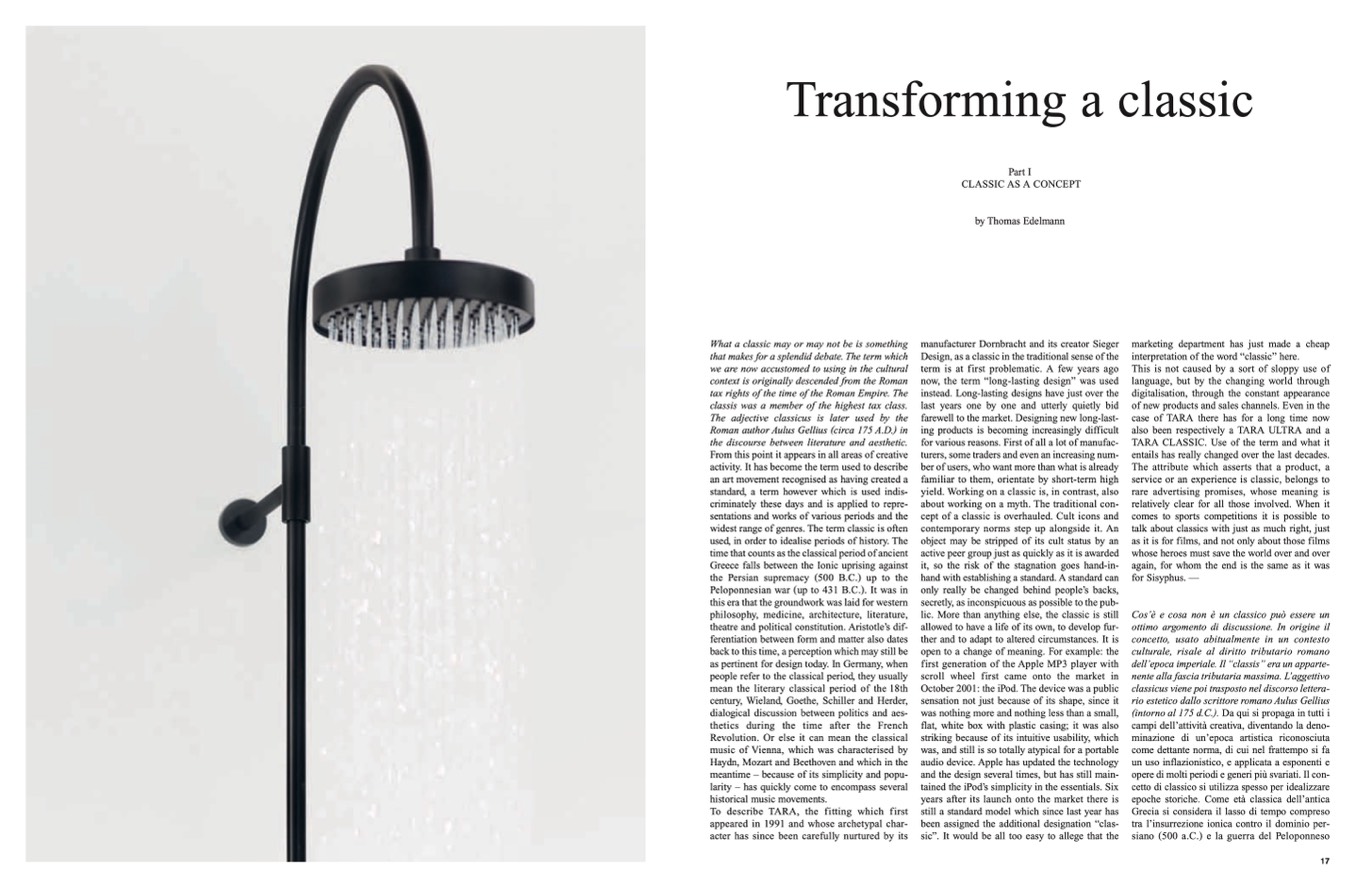
Transforming a classic
What a classic may or may not be is something
that makes for a splendid debate. The term which
we are now accustomed to using in the cultural
context is originally descended from the Roman
tax rights of the time of the Roman Empire. The
classis was a member of the highest tax class.
The adjective classicus is later used by the
Roman author Aulus Gellius (circa 175 A.D.) in
the discourse between literature and aesthetic.
From this point it appears in all areas of creative
activity. It has become the term used to describe
an art movement recognised as having created a
standard, a term however which is used indis-
criminately these days and is applied to repre-
sentations and works of various periods and the
widest range of genres. The term classic is often
used, in order to idealise periods of history. The
time that counts as the classical period of ancient
Greece falls between the Ionic uprising against
the Persian supremacy (500 B.C.) up to the
Peloponnesian war (up to 431 B.C.). It was in
this era that the groundwork was laid for western
philosophy, medicine, architecture, literature,
theatre and political constitution. Aristotle’s dif-
ferentiation between form and matter also dates
back to this time, a perception which may still be
as pertinent for design today. In Germany, when
people refer to the classical period, they usually
mean the literary classical period of the 18th
century, Wieland, Goethe, Schiller and Herder,
dialogical discussion between politics and aes-
thetics during the time after the French
Revolution. Or else it can mean the classical
music of Vienna, which was characterised by
Haydn, Mozart and Beethoven and which in the
meantime – because of its simplicity and popu-
larity – has quickly come to encompass several
historical music movements.
To describe TARA, the fitting which first
appeared in 1991 and whose archetypal char-
acter has since been carefully nurtured by its
Part I
CLASSIC AS A CONCEPT
by Thomas Edelmann
manufacturer Dornbracht and its creator Sieger
Design, as a classic in the traditional sense of the
term is at first problematic. A few years ago
now, the term “long-lasting design” was used
instead. Long-lasting designs have just over the
last years one by one and utterly quietly bid
farewell to the market. Designing new long-last-
ing products is becoming increasingly diff icult
for various reasons. First of all a lot of manufac-
turers, some traders and even an increasing num-
ber of users, who want more than what is already
familiar to them, orientate by short-term high
yield. Working on a classic is, in contrast, also
about working on a myth. The traditional con-
cept of a classic is overhauled. Cult icons and
contemporary norms step up alongside it. An
object may be stripped of its cult status by an
active peer group just as quickly as it is awarded
it, so the risk of the stagnation goes hand-in-
hand with establishing a standard. A standard can
only really be changed behind people’s backs,
secretly, as inconspicuous as possible to the pub-
lic. More than anything else, the classic is still
allowed to have a life of its own, to develop fur-
ther and to adapt to altered circumstances. It is
open to a change of meaning. For example: the
first generation of the Apple MP3 player with
scroll wheel first came onto the market in
October 2001: the iPod. The device was a public
sensation not just because of its shape, since it
was nothing more and nothing less than a small,
flat, white box with plastic casing; it was also
striking because of its intuitive usability, which
was, and still is so totally atypical for a portable
audio device. Apple has updated the technology
and the design several times, but has still main-
tained the iPod’s simplicity in the essentials. Six
years after its launch onto the market there is
still a standard model which since last year has
been assigned the additional designation “clas-
sic”. It would be all too easy to allege that the
marketing department has just made a cheap
interpretation of the word “classic” here.
This is not caused by a sort of sloppy use of
language, but by the changing world through
digitalisation, through the constant appearance
of new products and sales channels. Even in the
case of TARA there has for a long time now
also been respectively a TARA ULTRA and a
TARA CLASSIC. Use of the term and what it
entails has really changed over the last decades.
The attribute which asserts that a product, a
service or an experience is classic, belongs to
rare advertising promises, whose meaning is
relatively clear for all those involved. When it
comes to sports competitions it is possible to
talk about classics with just as much right, just
as it is for f ilms, and not only about those f ilms
whose heroes must save the world over and over
again, for whom the end is the same as it was
for Sisyphus. —
Cos’è e cosa non è un classico può essere un
ottimo argomento di discussione. In origine il
concetto, usato abitualmente in un contesto
culturale, risale al diritto tributario romano
dell’epoca imperiale. Il “classis” era un apparte-
nente alla fascia tributaria massima. L’aggettivo
classicus viene poi trasposto nel discorso lettera-
rio estetico dallo scrittore romano Aulus Gellius
(intorno al 175 d.C.). Da qui si propaga in tutti i
campi dell’attività creativa, diventando la deno-
minazione di un’epoca artistica riconosciuta
come dettante norma, di cui nel frattempo si fa
un uso inflazionistico, e applicata a esponenti e
opere di molti periodi e generi più svariati. Il con-
cetto di classico si utilizza spesso per idealizzare
epoche storiche. Come età classica dell’antica
Grecia si considera il lasso di tempo compreso
tra l’insurrezione ionica contro il dominio per-
siano (500 a.C.) e la guerra del Peloponneso
17

